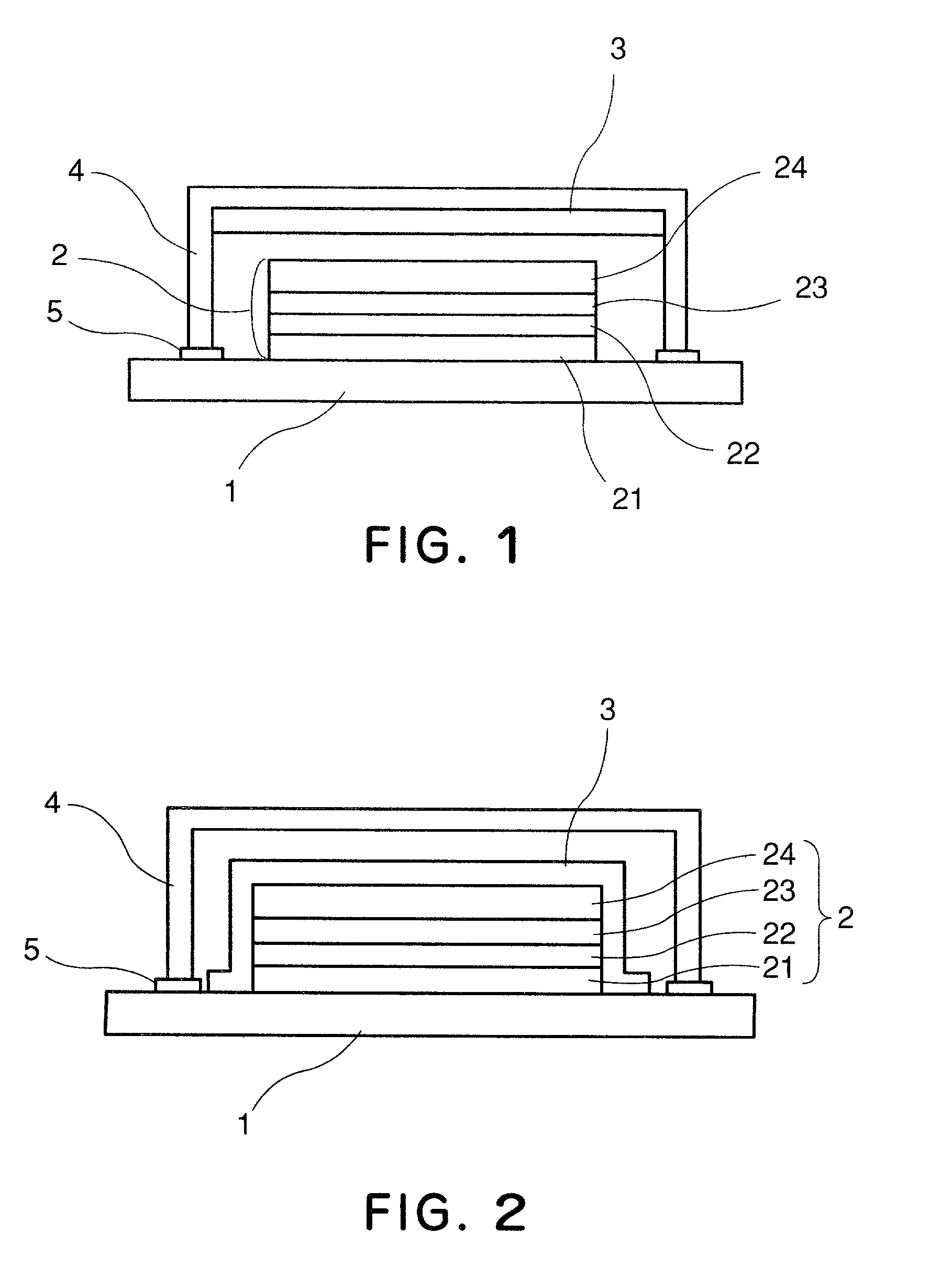Organic luminescence device
- Summary
- Abstract
- Description
- Claims
- Application Information
AI Technical Summary
Benefits of technology
Problems solved by technology
Method used
Image
Examples
example 2
[0050] An organic luminescence device as shown in
[0051] FIG. 1 was prepared and evaluated in the same manner as in Example 1 except that the isocyanate compound (Ex. Comp. No. 2) was changed to an isocyanate compound (Ex. Comp. No. 7, p-NCO) and the sealing step was performed in the following manner.
[0052] In a nitrogen gas atmosphere, an isocyanate compound (Ex. Comp. No. 7, p-NCO) was coated at an inner surface of a hermetic sealing housing 4 in the same manner as in Example 1 and a UV-curable adhesive 5 (acrylic resin) was applied at a peripheral edge of the hermetic sealing housing 4, followed by bonding of the hermetic sealing housing 4 to the glass substrate 1 and then UV light irradiation to cure the isocyanate compound and the UV-curable adhesive at the same time thereby to provide a hermetically sealed organic luminescence device.
[0053] As a result of evaluation, the organic luminescence device exhibited a good initial green luminescence state and growth of dark spots was n...
example 3
[0054] An organic luminescence device as shown in FIG. 1 was prepared and evaluated in the same manner as in Example 1 except that the isocyanate compound (Ex. Comp. No. 2) was changed to an isocyanate compound (Ex. Comp. No. 8) and the sealing step was performed in the following manner.
[0055] In a nitrogen gas atmosphere, an isocyanate compound (Ex. Comp. No. 8) was coated at an inner surface of a hermetic sealing housing 4 in the same manner as in Example 1 and subjected to heating at 100.degree. C. for 10 minutes to polymerize the isocyanate compound (Ex. Comp. No. 8), followed by bonding of the hermetic sealing housing 4 to the glass substrate 1 in the same manner as in Example 1 to form a hermetically sealed organic luminescence device.
[0056] As a result of evaluation, the organic luminescence device exhibited a good initial green luminescence state and growth of dark spots was not substantially observed similarly as in Example 1.
example 4
[0057] An organic luminescence device as shown in FIG. 2 was prepared and evaluated in the same manner as in Example 1 except that the isocyanate compound (Ex. Comp. No. 2) was changed to an isocyanate compound (Ex. Comp. No. 37) and the sealing step was performed in the following manner.
[0058] In a nitrogen gas atmosphere, an isocyanate compound (Ex. Comp. No. 37) was formed so as to cover a hermetic sealing housing 4 by vacuum deposition and an epoxy adhesive 5 was applied at a peripheral edge of the hermetic sealing housing 4, followed by bonding of the hermetic sealing housing 4 to the glass substrate 1 to form a hermetically sealed organic luminescence device.
[0059] As a result of evaluation, the organic luminescence device exhibited a good initial green luminescence state and growth of dark spots was not substantially observed.
PUM
 Login to View More
Login to View More Abstract
Description
Claims
Application Information
 Login to View More
Login to View More - R&D
- Intellectual Property
- Life Sciences
- Materials
- Tech Scout
- Unparalleled Data Quality
- Higher Quality Content
- 60% Fewer Hallucinations
Browse by: Latest US Patents, China's latest patents, Technical Efficacy Thesaurus, Application Domain, Technology Topic, Popular Technical Reports.
© 2025 PatSnap. All rights reserved.Legal|Privacy policy|Modern Slavery Act Transparency Statement|Sitemap|About US| Contact US: help@patsnap.com


